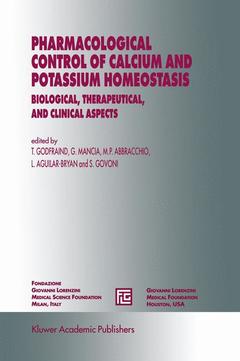Description
Pharmacological Control of Calcium and Potassium Homeostasis, Softcover reprint of the original 1st ed. 1995
Biological, Therapeutical, and Clinical Aspects
Medical Science Symposia Series, Vol. 9
Coordinators: Godfraind T., Mancia G., Abbracchio M.P., Aguilar-Bryan L., Govoni S.
Language: English
Subjects for Pharmacological Control of Calcium and Potassium Homeostasis:
Publication date: 10-2012
275 p. · 16x24 cm · Paperback
275 p. · 16x24 cm · Paperback
Description
/li>Contents
/li>
As the number of drugs acting on calcium and potassium channels grows, there is a need for a continuous reappraisal of the cellular machinery controlling them. The present volume provides an update on the basic knowledge, the molecular targets of the two channels, and the importance the drugs that bind them have as pharmacological tools and therapeutic agents. This work was presented at the 6th International Symposium on PHARMACOLOGICAL CONTROL OF CALCIUM AND POTASSIUM HOMEOSTASIS: BIOLOGICAL, THERAPEUTICAL, AND CLINICAL ASPECTS, in Florence (Italy) on October 4-6, 1994. Because of the recent advances in the field, discussions on potassium channels were included for the first time. At least six classes of voltage-dependent calcium channels have been defined based on their physiological and pharmacological properties. Among them, L-type channels, mediating long lasting currents, are better characterized. Calcium homeostasis within the cell is not only regulated by calcium channels; intracellular calcium stores, in particular a pool contained in the lumen of specialized areas of the endoplasmic reticulum, are rapidly exchanged with the cytoplasm and playa key role in the control of calcium homeostasis. This area, however, has not yet been exploited from a therapeutic point of view. Potassium channels are present in virtually every cell type, excitable and nonexcitable, and are distinguished by structural, biophysical, and pharmacological criteria. Different classes including voltage-gated, ligand-gated, AP-sensitive, and G-protein coupled among others, have been defined by their primary regulatory and gating mechanisms.
Preface. I: Molecular biology and pharmacology of cell calcium and potassium. II: Calcium and potassium regulation in cardiovascular pathophysiology. III: Calcium antagonists in cardiovascular therapy and organ protection. IV: Calcium and potassium manipulation in the prevention and reversal of structural changes in hypertension. V: Beyond blood pressure reduction: tissue protection by calcium antagonism can be enhanced by ACE inhibitors. VI: Multicenter Israpidine diuretic atherosclerosis study (MIDAS): results and lessons learned. VII: Calcium and potassium homeostasis in cerebral ischemia and neurodegenerative disorders. VIII: Molecular and clinical aspects of current and novel uses of potassium channel openers. Index.
© 2024 LAVOISIER S.A.S.
These books may interest you

Calcium Channel Pharmacology 158.24 €

Calcium Channel Blockers 158.24 €


